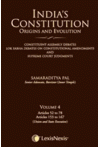
- Author(s): Samaraditya Pal
- Publisher: LexisNexis
- Edition: Ed 2015 Rp 2024
- ISBN 13 9789351434139
- Approx. Pages 832 + Contents
- Format Hardbound
- Approx. Product Size 24 x 16 cms
- Delivery Time 3-5 working days (within Kerala & South India) (Others 7-9 days)
- Shipping Charge Extra (see Shopping Cart)
Articles 52 to 78
Articles 153 to 167 (Union and State Executive)
............................................................................................
Description
In this volume, I have deviated from the Article-wise scheme adopted in the three earlier volumes covering Parts I to IVA as each of the Articles in those Parts carried specific concepts. Yet in a sense there is no deviation. The chapters of Parts V and VI which find a place have been presented Article by Article and the general scheme is not subjected to a major jolt, and more so because the Articles relating to the Union and the State Executives are almost pari materia to each other, barring certain provisions, as a result of which such Articles have been considered together. Parts V and VI reflect the basic federal character and the institutions representing that character. Part V relates to "the Union" and comprises five chapters. Chapter I deals with the Union or Central Executive, Chapter II deals with the Legislative Wing of the Union i.e. Parliament, Chapter III deals with the legislative powers of the President, Chapter IV deals with the Union Judiciary and Chapter V deals with the Comptroller and Auditor General of India. Part VI deals with "the States". Apart from some formal changes, the scheme of Part VI is almost the same (as is usual in a federal Constitution) except the chapters on the Union Judiciary (Chapter IV of Part V) and the State Judiciary (Chapter V of Part VI). It is to be noted that the heading of Chapter V is "The High Courts" and Chapter VI of Part VI deals with the "Subordinate Courts". In other words, whereas the Union Judiciary has been covered in one chapter, the Judiciary in the States has been dealt with in two chapters of Part VI.
............................................................................................
Table of Contents
Part V : Articles 52 to 78
Part VI : Article 153 to 167
Union and State Executive
Appendices
Appendix I
Appendix II
Subject Index
............................................................................................
Author Details
Samarditya Pal, Senior Advocate, Barrister (Inner Temple)
Deepa Kumar Sarkar, Advocate, High Court of Calcutta
